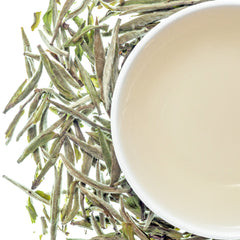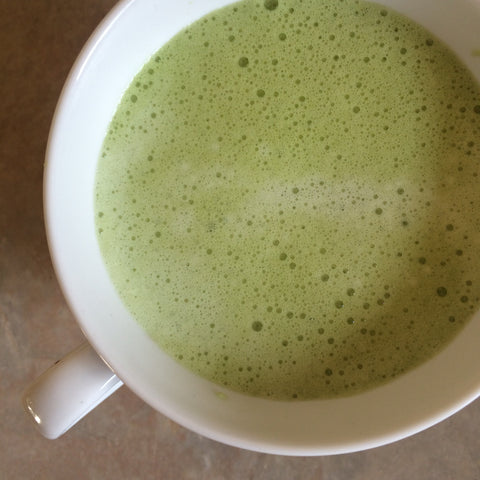-

The history of tea blending also has its shady side. In the late 1700’s when England levied huge taxes on tea, some tea drinkers responded by refusing to pay the taxes, declaring independence and setting up their own country. But in England many tea drinkers resorted to drinking smuggled tea. And those people smuggling the tea would secretly blend in many other ingredients into their tea , in order to make their tea stretch further, including; used tea leaves, oak and linden leaves, arsenic, chalk, dried seaweed. This led to some pretty bad tasting tea. Some companies responded by stressing the “purity” of their tea, see the accompanying ad. Also, some historians feel this illicit tea blending is a main reason the British developed the habit of using lots of milk and sugar in their tea; to cover the taste of all the other stuff blended into their tea.
View Post About Smugglers and Other Disreputable Tea Characters
-


Silver Needles (aka Yin Zhen) Big Red Robe (aka Da Hong Pao)
Yin & Yang: light and dark, male and female. This is a traditional Chinese way to consider the world. It can apply to people, societies, and tea. Some consider Silver Needles the lightest, most delicate, most beautiful of all teas. Compare that to Big Red Robe, which may be one of the darkest and strongest oolong teas. These teas come from a small area in northern Fujian, China. And for TeaSource, they both come from a supremely talented tea-making couple from that same region.
This fall, while speaking at the Xiaman International Tea Festival, I met a tea-making husband and wife team from Fuding, China; the ancestral home of Silver Needles the original great white tea.
Above: The first building of the Xiamean International Tea Festival. There were seven more of these buildings filled with tea and tea folk.
Ms. Yanmei Li exclusively makes Silver Needles from old tea bushes in the Fuding region.
Above: Yanmei is very proud of this tea. She learned the tea making craft from her father and grandfather.
Over the last 10 years, it has become increasingly difficult to source GREAT Chinese Silver Needles. When I tasted Yanmei’s Silver Needles at her booth, it took me back to 20 years ago; before Silver Needles was “discovered” by the West. This is the best Silver Needles I have had in a long time.
Above: Yanmei making Silver Needles white tea for me and my translator, Phoebe, and talking about her and her husband Eldon's work. Yanmei’s job is making Silver Needles for their small company. Eldon’s job is exclusively making Big Red Robe, specifically a baked oolong that is fired with a charcoal roasting process that he learned from his father. That is the whole company, except when they call in relatives to help out during busy times.

Above: The field and tea plants outside Fuding, China, from which our new Silver Needles comes, with Eldon and their new baby. For Yanmei and Eldon, making tea is a family affair.

Above: This is the field and plants used in the making of our new Big Red Robe. This field is in Anxi County, Fujian province - the traditional home of Big Red Robe. After plucking, the leaves are sent to Eldon in Fuding, where he combines tea making and alchemy to make an incredible and unique Big Red Robe tea.

Above: After the tea has gone through a typical oolong manufacturing process, they prepare special small pits where the tea is covered in charcoal.

Above: Here the tea is being “fired” with traditional charcoal roasting.

Above: When all the small tea pits are filled with tea, covered with charcoal, and fired, it is an incredible sight.
Above: The name of Yanmei and Eldon’s company, appropriately enough, is Share & Taste Tea. They believe in making the best tea they can, using the same techniques their elders did; and then sharing that tea and their love of tea with others.
So check out our new Silver Needles and our new Big Red Robe!
I am really enjoying these teas, and I am proud to know the folks who made them.
Bill Waddington, owner
TeaSource
-
A fabulous documentary about Chinese tea called Leaves of Change has been produced by Indianapolis Public Television. TeaSource founder Bill Waddington was involved and ended up being featured throughout this film. This documentary is available to all public television stations for broadcast- so call up your local public television station and ask them to carry Leaves of Change.

In the meantime, everyone can view this documentary online, for free, at this link:
http://www.pbs.org/video/2365622896/
“What a great film. They got all their facts straight, but more importantly they captured the feeling…the spirit of tea. And it is just a gorgeous, beautifully made film; although it is very disconcerting to see my own face up there. I’m way too Minnesotan to be comfortable with that.” - Bill Waddington
The film is succinct, only 30 minutes long; mostly shot in China (and a little in Minnesota) and an absolute joy to watch. It focuses on the role of tea in daily life, and how tea serves as a link to bring people and society together.
So check it out. We’re confident you’ll enjoy it. And please share this with your friends!
*At some point in the not too distant future this link will no longer work, so don’t forget to call and support your local public television station and request they broadcast this film.
-

Tea blends came about for two reasons; first to introduce new and unique tastes, aromas, and textures to a cup of tea. This is the fun, creative, and/or medicinal aspect of tea blending.
Secondly, tea blends make it possible to have absolute consistency in a pot of tea; from cup to cup, year to year, decade to decade. Since tea is an agricultural crop it can vary from year to year. It is only through blending various ingredients to balance the blend that this consistency can be achieved.
Purists may turn up their noses at tea blends; but the enjoyment of tea blends is almost as old as the discovery of tea itself. The Chinese have been making tea blends for 2500 years. The first book on tea, The Classic of Tea, by Lu Yu published around 760 A.D. talks of many items (mostly herbs and medicinals) that can be blended with tea. Two of the most famous tea blends are Jasmine tea and Earl Grey tea, both going back hundreds of years.
Traditionally, a given geographic area would blend into their tea whatever was produced or available locally. Southeastern China would blend in orange peels from their citrus groves. Tibet would blend in yak butter and salt. Indians would blend in local spices like cardamom, pepper, ginger. Eastern Europeans would blend in local fruits and berries.
To get a deeper look into Chinese teas, be sure to watch owner Bill Waddington in the PBS documentary about tea "Leaves of Change." Watch it here.
-
Check out some other ways our TeaSource staff is enjoying our new Matcha green teas. The possibilities are endless!
Organic Matcha Latte
1. Whisk ½ - 1 tsp of Organic Matcha in ¼ cup of water (heated to 175-180 degrees)
2. Add 6-8oz. of milk (heated 175-180 degrees)
3. Sweeten to taste (optional)
Matcha Raspberry Smoothie
1/2 frozen banana
1/2 cup frozen raspberries
1/2 cup frozen peaches
1/4 cup frozen strawberries
1/2-3/4 cup milk of your choice
1 1/2 cups baby spinach
1 tablespoon Organic Matcha
Combine all ingredients in a blender and blend until smooth.Enjoy!

-

Our summer has gotten easier and more refreshing thanks to our new Shake & Go tumbler! It is a convenient tool for making matcha – hot or iced. When the straw is removed, the cup seals making it leak-proof and spill-proof.
Here is how we shake up our new Matchas:
Hot Matcha in a Shake & Go
1. Put 4 level teaspoons of matcha and 16 oz. of boiling water in a Shake & Go tumbler
2. Shake until dissolved
Iced Matcha in a Shake & Go
1. Put 1 tablespoon of matcha and 8 oz. of boiling water in Shake & Go Tumbler
2. Shake until dissolved
3. Fill cup with ice
4. Shake well
Enjoy!













 Organic Matcha Latte
Organic Matcha Latte
